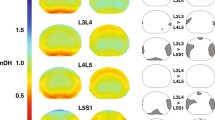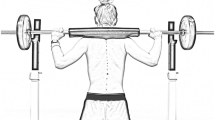Abstract
Low back pain is a leading cause of disability in the elderly. The potential role of spinal instability in increasing risk of low back pain with aging was indirectly investigated via assessment of age-related differences in viscoelastic response of lower back to passive deformation. The passive deformation tests were conducted in upright standing posture to account for the effects of gravity load and corresponding internal tissues responses on the lower back viscoelastic response. Average bending stiffness, viscoelastic relaxation, and dissipated energy were quantified to characterize viscoelastic response of the lower back. Larger average bending stiffness, viscoelastic relaxation and dissipated energy were observed among older vs. younger participants. Furthermore, average bending stiffness of the lower back was found to be the highest around the neutral standing posture and to decrease with increasing the lower back flexion angle. Larger bending stiffness of the lower back at flexion angles where passive contribution of lower back tissues to its bending stiffness was minimal (i.e., around neutral standing posture) highlighted the important role of active vs. passive contribution of tissues to lower back bending stiffness and spinal stability. As a whole our results suggested that a diminishing contribution of passive and volitional active subsystems to spinal stability may not be a reason for higher severity of low back pain in older population. The role of other contributing elements to spinal stability (e.g., active reflexive) as well as equilibrium-based parameters (e.g., compression and shear forces under various activities) in increasing severity of low back pain with aging should be investigated in future.






Similar content being viewed by others
References
Adams, M. A. Biomechanics of back pain. Acupunct. Med. 22(4):178–188, 2004.
Adams, M., and P. Dolan. A technique for quantifying the bending moment acting on the lumbar spine in vivo. J. Biomech. 24(2):117–126, 1991.
Adams, M., and P. Dolan. Time-dependent changes in the lumbar spine’s resistancc to bending. Clin. Biomech. 11(4):194–200, 1996.
Adams, M. A., et al. The Biomechanics of Back Pain. London: Churchill Livingstone, 2007.
Bazrgari, B., et al. Disturbance and recovery of trunk mechanical and neuromuscular behaviours following prolonged trunk flexion: influences of duration and external load on creep-induced effects. Ergonomics 54(11):1043–1052, 2011.
Best, T. M., et al. Characterization of the passive responses of live skeletal muscle using the quasi-linear theory of viscoelasticity. J. Biomech. 27(4):413–419, 1994.
Biely, S., M. S. S. Smith, and S. P. Silfies. Clinical instability of the lumbar spine: diagnosis and intervention. Analysis. 6:7, 2006.
Biering-Sørensen, F. Low back trouble in a general population of 30-, 40-, 50-, and 60-year-old men and women. Study design, representativeness and basic results. Dan. Med. Bull. 29(6):289–299, 1982.
Biering-Sørensen, F. A prospective study of low back pain in a general population. I. Occurrence, recurrence and aetiology. Scand. J. Rehabil. Med. 15(2):71–79, 1982.
Bressler, H. B., et al. The prevalence of low back pain in the elderly: a systematic review of the literature. Spine. 24(17):1813, 1999.
Buckwalter, J. A. Aging and degeneration of the human intervertebral disc. Spine. 20(11):1307–1314, 1995.
Cholewicki, J., M. M. Panjabi, and A. Khachatryan. Stabilizing function of trunk flexor-extensor muscles around a neutral spine posture. Spine 22(19):2207–2212, 1997.
Chou, R., and L. H. Huffman. Medications for acute and chronic low back pain: a review of the evidence for an American Pain Society/American College of Physicians clinical practice guideline. Ann. Intern. Med. 147(7):505–514, 2007.
Dupuis, P. R., et al. Radiologic diagnosis of degenerative lumbar spinal instability. Spine. 10(3):262–276, 1985.
Ferrari, S., et al. A literature review of clinical tests for lumbar instability in low back pain: validity and applicability in clinical practice. Chiropr. Man. Ther. 23(1):14, 2015.
Fortin, M., et al. Paraspinal muscle morphology and composition: a 15-yr longitudinal magnetic resonance imaging study. Med. Sci. Sports Exerc. 46(5):893–901, 2014.
Galbusera, F., et al. Ageing and degenerative changes of the intervertebral disc and their impact on spinal flexibility. Eur. Spine J. 23(3):324–332, 2014.
Gay, R. E., et al. Sagittal plane motion in the human lumbar spine: comparison of the in vitro quasistatic neutral zone and dynamic motion parameters. Clin. Biomech. 21(9):914–919, 2006.
Goel, V., K. Iron, and J. Williams. Indicators of health determinants and health status. Patterns HealthC. Ont. ICES Pract. Atlas 2:5–26, 1996.
Hendershot, B. D., et al. Evidence for an exposure-response relationship between trunk flexion and impairments in trunk postural control. J. Biomech. 46(14):2554–2557, 2013.
Henry, S. M., et al. Decreased limits of stability in response to postural perturbations in subjects with low back pain. Clin. Biomech. 21(9):881–892, 2006.
Horak, F. B., and L. M. Nashner. Central programming of postural movements: adaptation to altered support-surface configurations. J. Neurophysiol. 55(6):1369–1381, 1986.
Horal, J. The clinical appearance of low back disorders in the city of Gothenburg, Sweden: comparisons of incapacitated probands with matched controls. Acta Orthop. 40(S118):1–109, 1969.
Izzo, R., et al. Biomechanics of the spine. Part II: Spinal instability. Eur. J. Radiol. 82(1):127–138, 2013.
Koeller, W., et al. Biomechanical properties of human intervertebral discs subjected to axial dynamic compression—influence of age and degeneration. J. Biomech. 19(10):807–816, 1986.
Lawrence, R. C., et al. Estimates of the prevalence of arthritis and selected musculoskeletal disorders in the United States. Arthritis Rheum. 41(5):778–799, 1998.
Lee, B. C., and S. M. McGill. Effect of long-term isometric training on core/torso stiffness. J. Strength Cond. Res. 29(6):1515–1526, 2015.
Leipholz, H. Stability Theory: An Introduction to the Stability of Dynamie Systems and Rigid Bodies. New York: Academie Press, 1970.
Little, J. S., and P. S. Khalsa. Human lumbar spine creep during cyclic and static flexion: creep rate, biomechanics, and facet joint capsule strain. Ann. Biomed. Eng. 33(3):391–401, 2005.
Manchikanti, L. Epidemiology of low back pain. Pain Physician. 3(2):167–192, 2000.
McGill, S., J. Seguin, and G. Bennett. Passive stiffness of the lumber torso in flexion, extension, lateral bending, and axial roatation: effect of belt wearing and breath holding. Spine. 19(6):696–704, 1994.
Moorhouse, K. M., and K. P. Granata. Role of reflex dynamics in spinal stability: intrinsic muscle stiffness alone is insufficient for stability. J. Biomech. 40(5):1058–1065, 2007.
Nerlich, A. G., E. D. Schleicher, and N. Boos. Volvo Award winner in basic science studies: immunohistologic markers for age-related changes of human lumbar intervertebral discs. Spine. 22(24):2781–2795, 1997.
Panjabi, M. M. The stabilizing system of the spine. Part I. Function, dysfunction, adaptation, and enhancement. J. Spinal Disord. Tech. 5(4):383–389, 1992.
Panjabi, M. M. Clinical spinal instability and low back pain. J. Electromyogr. Kinesiol. 13(4):371–379, 2003.
Reeves, N. P., et al. The effects of trunk stiffness on postural control during unstable seated balance. Exp. Brain Res. 174(4):694–700, 2006.
Roughley, P. J. Biology of intervertebral disc aging and degeneration: involvement of the extracellular matrix. Spine 29(23):2691–2699, 2004.
Sanjeevi, R. A viscoelastic model for the mechanical properties of biological materials. J. Biomech. 15(2):107–109, 1982.
Shin, G., M. L. Nance, and G. A. Mirka. Differences in trunk kinematics and ground reaction forces between older and younger adults during lifting. Int. J. Ind. Ergon. 36(9):767–772, 2006.
Shojaei, I., N. Arjmand, and B. Bazrgari. An optimization‐based method for prediction of lumbar spine segmental kinematics from the measurements of thorax and pelvic kinematics. Int. J. Numer. Methods Biomed. Eng. 2015. doi:10.1002/cnm.2729.
Shojaei, I., et al. Age related differences in mechanical demands imposed on the lower back by manual material handling tasks. J. Biomech. 2015. doi:10.1016/j.jbiomech.2015.10.037.
Solomonow, M. Ligaments: a source of musculoskeletal disorders. J Bodyw. Mov. Ther. 13(2):136–154, 2009.
Song, J., and X. Qu. Effects of age and its interaction with task parameters on lifting biomechanics. Ergonomics 57(5):653–668, 2014.
Toosizadeh, N., and M. A. Nussbaum. Creep deformation of the human trunk in response to prolonged and repetitive flexion: measuring and modeling the effect of external moment and flexion rate. Ann. Biomed. Eng. 41(6):1150–1161, 2013.
Toosizadeh, N., et al. Load-relaxation properties of the human trunk in response to prolonged flexion: measuring and modeling the effect of flexion angle. PloS One 7(11):e48625, 2012.
Toossi, M. Labor force projections to 2020: a more slowly growing workforce. Mon. Lab. Rev. 135:43, 2012.
Twomey, L., and J. Taylor. Sagittal movements of the human lumbar vertebral column: a quantitative study of the role of the posterior vertebral elements. Arch. Phys. Med. Rehabil. 64(7):322–325, 1983.
Van Dieen, J. H., et al. Increased cocontraction of trunk muscles as a cause of impaired balance control. In: Proceedings of the International Society for the Study of the Lumbar Spine, Porto, Portugal, 2004.
Vazirian, M., et al. Age-related differences in trunk intrinsic stiffness. J. Biomech. 2015. doi:10.1016/j.jbiomech.2015.09.010.
Vernon-Roberts, B., R. J. Moore, and R. D. Fraser. The natural history of age-related disc degeneration: the pathology and sequelae of tears. Spine 32(25):2797–2804, 2007.
Yahia, L., J. Audet, and G. Drouin. Rheological properties of the human lumbar spine ligaments. J. Biomed. Eng. 13(5):399–406, 1991.
Zirbel, S. A., et al. Intervertebral disc degeneration alters lumbar spine segmental stiffness in all modes of loading under a compressive follower load. Spine J. 13(9):1134–1147, 2013.
Acknowledgment
This work was supported by an award (R21OH010195) from the Centers for Disease Control and Prevention (CDC). Its contents are solely the responsibility of the authors and do not necessarily represent the official views of the CDC. The authors thank assistances of R. Tromp, E. Croft, and M. Vazirian in data collection.
Author information
Authors and Affiliations
Corresponding author
Additional information
Associate Editor Peter E. McHugh oversaw the review of this article.
Rights and permissions
About this article
Cite this article
Shojaei, I., Allen-Bryant, K. & Bazrgari, B. Viscoelastic Response of the Human Lower Back to Passive Flexion: The Effects of Age. Ann Biomed Eng 44, 2817–2826 (2016). https://doi.org/10.1007/s10439-016-1569-7
Received:
Accepted:
Published:
Issue Date:
DOI: https://doi.org/10.1007/s10439-016-1569-7




